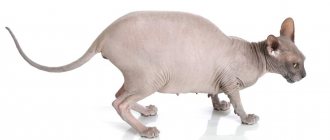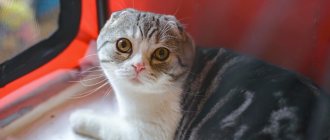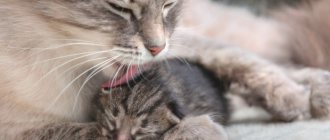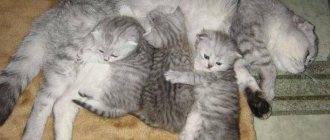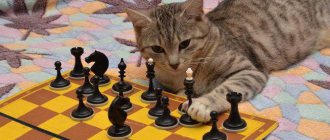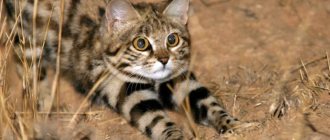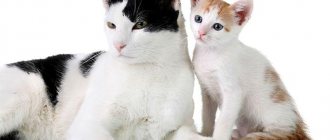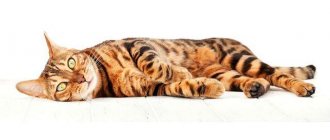- Cats
- General issues
Domestic cats are the most popular pets for modern city dwellers. Living side by side with furry creatures, you involuntarily begin to wonder what the origin of cats is, where these graceful and unique animals came from, what part of the world can be considered the homeland of mustachioed pets. Of particular interest are the issues of domestication and taming of the wild counterparts of modern furry beauties.
Creodont cat's ancestors
This is the official version of the origin of the cat. Scientists believe that the first cats were evil creodonts. They ate meat, cruelly dealing with their next prey, and were much larger in size than the tiger we know, and even more so than the beloved domestic cat. All scientists adhere to this version, although they do not have direct evidence of it. When children ask where cats came from, they are often told this version.
Creodonts inhabited the vastness of the Earth fifty million years ago. These were dangerous predators that terrified all representatives of the fauna. Everything that moved, ran away, and chewed was eaten.
Many years later, thanks to evolution and amazing transformations, the first lions, saber-toothed tigers, and cheetahs appeared. And after thousands of years, we were able to see a cat that we can take home with pleasure and without fear. But this is too simple an answer to the question of where domestic cats came from. Let's look into mythology?
Modern felines
All modern cats belong to the family of mammals and the order of carnivores. Their sizes can vary from 30 centimeters to almost 4 meters in length. Weight varies from 1 kg to 300 kg depending on the type.
© shutterstock
All cats have many common characteristics:
- when walking they step on their toes;
- there are 5 toes on the front paws, 4 toes on the hind paws;
- claws can be retracted and extended (in almost all species);
- number of teeth – up to 30;
- the rough surface of the tongue, thanks to which you can clean your fur and lick the remains of meat from the bones of prey;
- the ability to hear high-frequency sounds inaccessible to humans;
- small cats purr as they inhale and exhale, and large cats purr as they exhale.
All modern cats are divided into two subfamilies:
- small cats;
- big cats.
When compiling this classification, phenotypic classifications as well as genotypic lines were taken into account. Previously, in addition to large and small cats, there was also a subfamily of saber-toothed cats, which became extinct about 11 thousand years ago.
Small cats include the following genera of felines::
- Asian cats;
- cheetahs;
- golden cats;
- caracals;
- catopums;
- cats (including domestic cats);
- marble cats;
- cougars.
- lynx;
- servals;
- tiger cats;
Previously, cheetahs were classified into a separate subfamily - cheetahs. But thanks to modern science, studies have been carried out on the genes and genetic relationships of cheetahs, and their close relationship with pumas was discovered.
© shutterstock
Big cats include the following genera of the cat family:
- clouded leopards;
- panthers (which include lions, tigers, leopards, jaguars, leopards).
The word "panther" often refers only to black-colored cats, and there is a stereotype that it is a separate species. But the black color appeared as a result of a mutation in the gene responsible for pigmentation. The most common black panthers are leopards and jaguars.
Felines live on land, preferring forests, deserts, and mountains. Most of these animals live in the tropics and subtropics, but some species are also found in temperate climates.
Cats appeared on the planet several million years ago and now wild cat species are present in all corners of the planet. The only exceptions are Australia, Antarctica, Greenland, Madagascar, Sulawesi, and New Guinea.
A distinctive feature of the entire cat family is that they have approximately the same habits and habits. After observing a domestic cat, you will notice that its behavior is practically no different not only from a street cat, but also from a “relative” of another subspecies that has spent its entire life in the wild, hunting and fighting with other animals.
Noah's Ark didn't carry cats.
Everyone knows about the purpose of the legendary Noah's Ark. This huge ship became a salvation for all types of animals. Only there were no cats then, and therefore they were not on Noah’s ark. As the legend says, during the long voyage, animal excrement began to greatly interfere with normal existence.
Mice and rats multiplied at such a speed that food supplies might not be enough until the end of the voyage, since the rodents ate everything. People and animals were threatened with terrible starvation, and God himself again came to the rescue. He told Noah to stroke the elephant's trunk, and at the same moment a pig appeared from the trunk, it destroyed all the fetid excrement. Then Noah, again on the advice of the Almighty, stroked the lion's nose, and a cat appeared from it. It was she who saved the inhabitants of the ark by catching all the mice.
Cats are a luxury
Initially, cats were very expensive, there were few of them, and there was a huge fine for their theft. The church helped to breed cats; cats were settled in monasteries, in rich houses and in royal palaces. Naturally, at first few people could afford to keep these rare (still) animals; it was simply beyond the means of the majority of the population.
Then, over time, there were more and more cats. And tailed rodent destroyers began to be found in many houses, and even in village huts.
Cats came from the cat planet
I would like to believe in the unearthly origin of cats. The first images of these creatures appeared in Egypt, and there is a myth that it was in Egypt that the first cat aliens arrived. They were completely bald and could communicate with people with the power of thought.
As the legend says, one of the cats wandered into the forest and met there an ordinary and shaggy steppe cat. They fell in love with each other, and the bald cat refused to leave the Earth, she chose love. The couple was happy throughout their cat life, and they produced furry offspring that became the ancestors of today's domestic cats.
How did domestic cats appear?
The ancient Egyptians had a special relationship with cats: they were revered as sacred animals; mummified like people; depicted in sculpture and frescoes. And the very first cat “portrait” was painted by the Egyptians. It was a painting in one of the tombs south of Cairo, made around 1950 BC. e., that is, almost four thousand years ago. It shows a cat staring intently at an approaching rat.
Picture: Larazoni / Wikimedia Commons.org.
The ancestor of the domestic cat is the steppe cat, which has a “wild” tabby coloration. Photo: Sonelle at English/Wikipedia/CC BY-SA 3.0.
Cat mummies. Exhibits from the British Museum. Photo: www.britishmuseum.org.
Bast, or Bastet. In Ancient Egypt, the goddess of joy, fun and love, fertility and hearth. She was depicted as a woman with the head of a cat. Picture: Gunkarta/ Wikimedia/ CC BY-SA 3.0.
The Egyptian Mau is an ancient breed that has undergone natural selection. Her appearance has not undergone significant changes for 3000 years. In the photo: Egyptian Mau of silver color. Photo: Lil Shepherd/Wikipedia/CC BY 2.0.
A modern wild-colored domestic cat. Photo: Jens Nietschmann/Wikipedia/CC BY-SA 3.0.
Bicolor domestic cat. Photo by Ekaterina Krichmar.
Siamese color. A cat's paws, tail, head and ears are usually darker in color. Photo by Alexey Karpushin.
Tricolor cat: white, black and red. Photo by Marina Slyusar.
A Bengal cat with a leopard pattern on its coat, characteristic only of this breed. This animal inherited this feature from its wild ancestors thanks to long-term selection. Photo: steveheap/ ru.depositphotos.com.
Photo by Alina Nesterovskaya.
‹
›
For quite a long time it was believed that the Egyptians tamed cats. However, in 2004, a burial dating back to 9500 BC was discovered in Cyprus. e., in which a cat was found along with a man. A wild animal would hardly be put in a grave. It turned out that cats lived with people long before they appeared in Egypt. The Middle East began to be considered the homeland of domestic cats, and for some time they forgot about Egypt. But not for long: in 2008, a burial was discovered in the south of Egypt, in which they found six cats - a male, a female and four kittens. Although this burial was younger than the Cypriot burial (about 6,000 years), it became clear that cats were known in Egypt much earlier than was believed until recently.
It is known that the ancestor of the domestic cat was the steppe cat Felis silvestris lybica - it still lives in the steppe, desert and partly mountainous regions of Africa, Western, Central and Central Asia, Northern India, Transcaucasia and Kazakhstan. In 2007, it was established that all modern cats originated from him.
Over time, domestic cats accumulated certain changes in their genome, and if we trace how and when such changes occurred using ancient animal remains, we can determine exactly where domestic cats first appeared and how they spread across the globe.
This is exactly what Eva-Maria Geigl and Thierry Granger from the Jacob Monod Institute (France) tried to do, together with colleagues from scientific centers in Australia, Armenia, Romania, Germany and other countries. They analyzed more than two hundred DNA samples taken from the remains of cats ranging in age from 100 to 9,000 years old, which were found during archaeological excavations in Europe, Africa and the Middle East. For the analysis, we used not ordinary nuclear DNA, but the one contained in mitochondria. Mitochondrial DNA is transmitted only through the maternal line, since after fertilization the embryo retains only those mitochondria that were in the egg. Using such DNA, it is relatively easy to reconstruct the female line of the family tree, without being distracted by paternal genes.
The steppe cat has its own “mitochondrial portrait” - characteristic features in the mitochondrial DNA that distinguish it from other related species. An article published in the journal Nature Ecology & Evolution reports that domestic cats, which are most similar in mitochondrial genome to the steppe cat, first appeared 9,000 years ago in burials excavated in modern Turkey. And this is quite consistent with the “Middle Eastern” hypothesis: it was in these places, about 10,000 years ago, that wild cats discovered that near food supplies made by humans, rodents were found in abundance and that it was therefore better to be friends with people. The mitochondrial profile of such cats was called “type A”. Approximately 4400 BC. e. cats of this type appear on the territory of modern Bulgaria, 3200 BC. e. - where Romania is now, and then they spread throughout the rest of Europe, Asia and Africa. Since cats are characterized by territoriality and are not inclined to long journeys, animals were obviously able to quickly settle on all continents only with the help of people.
But let's return to Egypt. It turned out that the mitochondrial DNA of Egyptian cat mummies differs from the DNA of “type A” cats. "Egyptian women" were designated "type C", and the first of them date back to around 800 BC. e. It is possible that “type C” cats appeared in Egypt earlier, but it was not possible to extract the amount of DNA required for analysis from more ancient burials.
Over time, Egyptian cats became very popular: by the fifth century AD they could be found throughout Europe and throughout the Mediterranean, and by the end of the first millennium in some places they completely replaced Middle Eastern cats. The popularity of “type C” cats can be explained by the notorious special attitude of the Egyptians towards these animals: there were more and more cats in Egypt, and here among them, which is especially important, they selected not only good hunters, but also pleasant “roommates” who had gotten rid of the wild quarrelsomeness. The changes that gradually took place in Egyptian cats can also be traced in Egyptian art: at first the animals were depicted doing some useful activity, such as catching rats, but then the cats in the paintings became more and more “domesticated” and became closer to people - they already caught with their owners birds, they have collars, they sit under the chair while people are busy having lunch, as in one of the frescoes dating back to about 1500 BC. e.
But where did the “type C” cat come from in Egypt? It can be assumed that the Egyptians domesticated cats independently of other peoples, taking as a basis the local population of steppe cats, whose mitochondrial DNA, after domestication from scratch, gave “type C” - in this case, local domestic cats originated here. But it could have been different: first, Middle Eastern “type A” cats appeared in Egypt, which later, as a result of crossing with local wild cats, turned into “type C” cats. And subsequently, the Egyptians kept at home just such domestic cats with “wild” genetic additives.
Be that as it may, all modern cats are a mixture of “type A” and “type C”. And even if the Egyptians themselves did not domesticate anyone, it was they who made cats everyone’s favorites, teaching them communication and affection. It is curious that the genes that control color in domestic cats remained unchanged for a very long time, and only around the 14th century AD. e. animals appear whose “wild” striped coloring “spreads” into various spots and “blots”. If we take dogs or horses for comparison, then they “changed into domestic clothes” quite early, but probably no one cared about the appearance of cats for a long time - the main thing is that they learn to behave in the house.
In 2001, during excavations in Central China, in the town of Quanhucun, where there was once a farm of prehistoric farmers, several cat bones were found that were 5,300 years old. Analysis of the remains showed that these were domestic cats: they ate some animals, which, in turn, ate cereals (that is, obviously, the cats hunted small rodents), and people clearly took care of them (part of the bones belonged to a rather old a beast that most likely would not have lived to that age without human help). The question was where did these animals come from: did they come with Middle Eastern traders or were they domesticated right here? Researchers from the Sorbonne and the University of Aberdeen, together with Chinese colleagues, came to the conclusion that all the prehistoric cat bones that were found in China belong to the Bengal cat - Prionailurus bengalensis. In a paper published last year in the scientific journal PLoS ONE, the authors make several arguments that these were not just wild animals that roamed near human settlement, but cats in the early stages of domestication. Let's list these arguments: some of the remains belonged to cats that were slightly smaller than wild individuals (that is, the process of domestication was already underway), and one of the cats was buried entirely, which indicates a special relationship between the animal and the person.
However, the “experiment” to domesticate the Bengal cat ended in nothing: over time, long-tamed descendants of the steppe cat appeared in China, who were more obedient, more useful in the household and who knew better what people wanted from them, and the people themselves understood what their cat meows.
Cats are born from the sun god
Peering into the piercing and deep eyes of the purr, the question naturally arises in your head about where cats came from. These graceful creatures seem to be mystical creatures sent to us by the Creator himself.
According to the wisest pharaoh Akhenaten, he was the son of the sun god and his half-brothers and sisters were cats. Only he was born in human form. It’s not for nothing that our pets’ bodies are filled with such warmth that can cure all human ailments. Does it seem fantastic? But Pythagoras, one of the smartest people of antiquity, did not think so. He adhered to the opinion of Akhenaten and had already built his hypothesis of the extraterrestrial origin of cats when his life expired. He died without proving to people that cats are real deities. Everyone ridiculed Pythagoras and did not believe him, but this man made a huge contribution to science.
Messengers from distant stars
No matter how funny it may seem, there are many great minds who are completely sure that cats literally fell to Earth from the Moon!
Plotinus (Neoplatonist philosopher) was even able to argue his opinion about the origin of cats. He wrote in the Ennead irrefutable evidence specifically in favor of the Moon. In his opinion, cats are creatures of this satellite because they see well in the dark, are active at night, and their behavior depends on the phases of the moon.
According to Augustine the Blessed, who wrote the work “On the City of God,” cats are sent to us from those very distant stars where the human soul resides after death. The Almighty only showed them the way there and back, and they can communicate with spirits. But it’s not for nothing that people are sure that cats get along well with ghosts and see them, which is not given to humans.
Where did the word “cat” come from in Rus'...
Despite the fact that countries such as China or England are located much further from Egypt than Rus', the inhabitants of these countries managed to get acquainted with cats earlier than us. Many people know that cats are of Egyptian origin. But even the word “cat” itself is not originally Slavic and was borrowed from the Latin language, where wild cats are designated by the word “cattus”. This is where the word “cat” comes from. Few people also know that the female domestic cat was called “kotka” in Rus' until the 16th century. By the way, in some Slavic languages the ancient form of this word has been preserved to this day.
The history of cats in Rus' began later than their history in England.
NASA says aliens look like cats
Perhaps it was not for nothing that in the Middle Ages people believed that the cat was an unearthly creation. Not long ago, everyone was stunned by the news about the discovery of American astronauts. The guys landed on the moon and found many unusual objects there. They resembled small coins in size. Having brought the artifacts with them, the astronauts sent them to the laboratory. The result of the analysis simply shocked everyone: a similar composition exists on Earth, this is cat feces. Well, tell me, where did they come from on the Moon?
Since then, NASA scientists began to develop the hypothesis that cats are real aliens and all aliens look exactly like this!
Wild Middle Ages
I would like to take a little break from thinking about where cats came from and talk about their role in human life. Now these animals are not in danger, but just recently cats were subjected to terrible torture and executions. People believed that purrs were assistants to witches and the devil himself and burned them at the stake.
There was another, no less terrible, killing of cats. During the Middle Ages, once a year a holiday was held in the city of Ipern, it was called “Cat Day”. For the cats themselves, this day did not bode well; they were thrown in huge quantities from the highest towers.
In the 18th century, a bishop from Germany ordered all cats to have their ears and tails cut off, while at the same time the kings of France had fun watching purring cats suffer at the stake.
A nightmare, and that's all. Only in Egypt were cats deified, cared for during their lifetime, and all representatives of the tailed family lived in luxury. After death, cats were mummified and buried next to the pharaohs.
In Russia, from the very beginning, this beast was not considered by people to be either a god or a devil; it was kept for catching mice and rats. By the way, where did cats come from in Russia?
The appearance of cats in Rus'
Excavations carried out in Russia and the former Soviet Union have shown that cats appeared on our lands in the seventh century. But the first descriptions of these animals are in documents dating back to the eleventh century. It is assumed that foreign sailors brought strange animals to Russia and sold them for huge sums of money. People liked this creature, because its eyes glow in the dark, and from any height it falls on all four paws, and even purrs!
Over time, the cats began to breed and multiply, and now in the peasant huts the beast caught mice and rats, protecting the owner's supplies.
There is a legend that Peter the Great himself adored these creatures and, seeing how another cook was chasing a fluffy one, declared cats to be inviolable creatures. You may ask, why does a chef need a cat? This animal simply brought him a dead rat as proof of its work and irreplaceability and placed it on the cutting table. That's all. But since then no one could offend the tailed one in Rus'.
Cats in Russian culture
These animals have become an integral part of the life of Russian people. In Rus', they were heroes of legends and fairy tales, one of the most famous characters is the cat Bayun.
Until the beginning of the twentieth century, merchants competed to see whose cat was fatter and fatter (which, in fact, is not the best thing to boast about, because obesity is no less harmful to cats than to people).
In 1853, Vladimir Ivanovich Dal published a collection of two volumes called “Proverbs of the Russian People.” There are about 75 proverbs about cats in this work.
Where did Siamese cats come from?
The Siamese cat, which many associate with a demon, originated in Thailand between 1350 and 1750. This is a purebred animal, and man made no effort to breed the breed.
The first Siamese are described in writings from the 19th century. It says that these cats were considered sacred animals and were kept in Buddhist temples. Only priests and royal families were allowed to have them.
Today everyone can afford this breed of pet; they are bred in nurseries.
Where did Sphynx cats come from?
In fact, there are a huge number of sphinx breeds and not all are popular. Where did hairless cats come from? This question torments many people. Descriptions of hairless cats have been available since ancient times; the Aztecs could have been their owners.
At all times, hairless kittens have been born on the territory of our planet. They were of no interest to people and were simply destroyed. A resident of Canada was the first to decide to breed the breed when, in 1966, he discovered a hairless cat in his cat’s litter. The baby was named Prunt and later brought together with his mother. Both normal and hairless kittens were born again. Then hairless cats and female cats were bred until shaggy creatures completely disappeared from the litters. This is how the now popular sphinxes appeared, and they owe their origin to an ordinary mutation.
What if the legend is true, and once upon a time hairless alien cats visited our Earth, and now cats give birth to hairless kittens, reminding them of their origin? This will forever remain a secret!
